Product Featured
Model: Pioneer DJ DJM-V10Release Price: $3,499 (contact by livechat, phone or email for discount)
Released: January, 2020
Model: Pioneer DJ DJM-V10-LF
Release Price: $3,599 (contact by livechat, phone or email for discount)
Released: November, 2020
This Pioneer DJ review was produced by David Michael at The Passionate DJ Podcast.
[/alert]The Basics
The Pioneer DJ DJM-V10 is a 6-channel club-style mixer, loaded with unique features that produces audio full of energy and presence. 32-bit high-quality A/D and D/A converters, a low-jitter clock circuit, and a bunch of other high-quality components combine to make for a lovely-sounding mixer that’s ready to handle whatever sound source you want to throw at it.
In addition to Pioneer DJ’s classic Beat FX setup, the V10 has a robust Send system. You can connect up to two external FX devices (e.g. guitar pedals), or use the four built-in send FX. The V10 also steps up to a 4-band EQ system, for further control over the mix. It even includes a compressor on each channel, to help bring older tracks up-to-snuff. A dual cue system makes it easy for multiple performers to use the mixer, and dual USB connections are provided for multiple laptop connections.
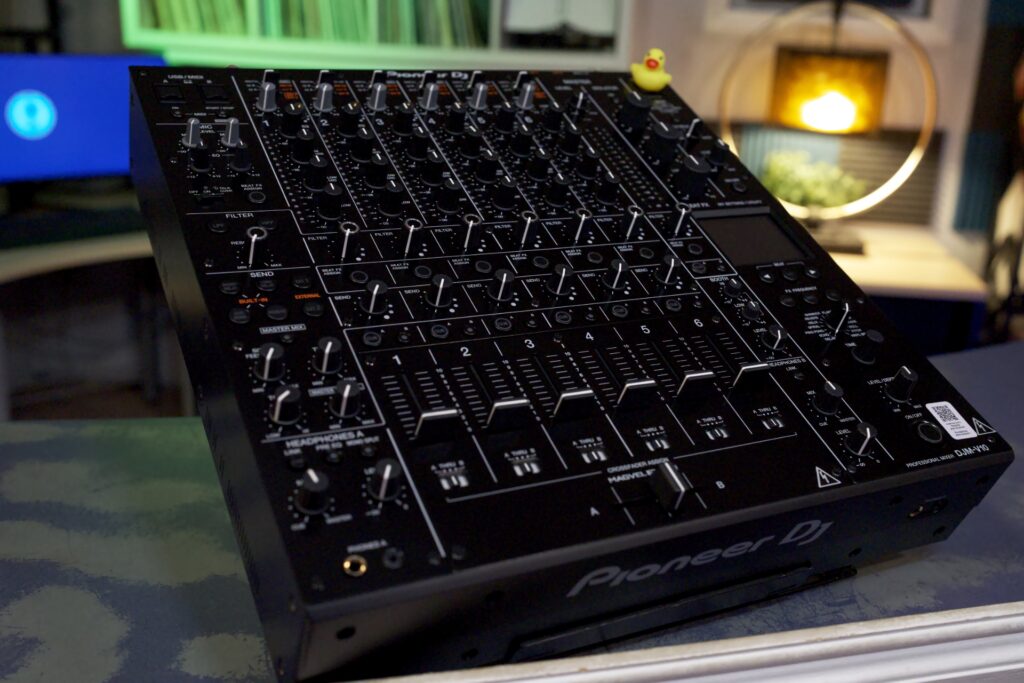
Making a Mix
I decided to make a techno mix, as the V10 is very well suited for this sort of thing. To hear my progress, follow along in the video above. I used channels 3 and 4 for two digital tracks, in this case provided by Rekordbox software over USB. This could just as easily be two CDJs or some other software.
I decided to set the gains for these and leave them alone, since they are modern mastered tracks. I usually try to land at the middle of the white lights, or about 6 db at the loudest part of a song. This makes it nice and loud in the mix, but gives a little bit of room for error.
Next, I’m going to take advantage of the Master Isolator. I noticed I got a great sound through my QSC speakers (without sub), by boosting each frequency band just a little bit (to about the 2 o’clock position). This replaced some of the low-end kick that I’m missing by not having a sub hooked up, while giving some extra sizzle to the highs. I didn’t want to overdo it, but just add a bit of the V10’s color to the sound. Next, I introduced a vinyl record. But, because records need to be mastered differently, and because this song was released at the turn of the millennium when music was a little less compressed, this record sounds a bit weak in the mix. That’s where the V10’s built-in compressor comes in. Compressors make quiet parts of a sound louder, and when used correctly, can improve the overall perceived loudness of a track.
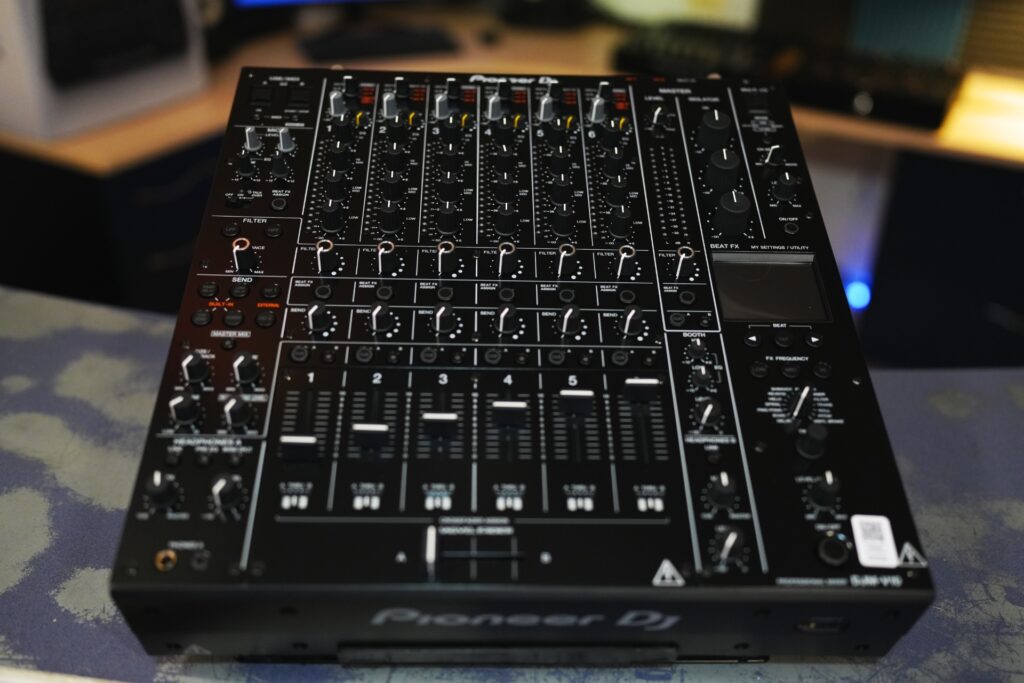
Instead of cranking the gain way up, I’m going to just get it tapping the white lights, and then use the compressor to bring it the rest of the way. I’m also going to increase the two higher EQ bands, because this old record has definitely had that needle dragged across it many times, and it’s lost a bit of treble.
This makes it much beefier, and it sounds much more like it can compete with the modern songs we’ll be mixing it with. Hear a before and after comparison, in the video above.
Now, let’s get really weird with it. I want to add a live synth, and in this case, a “live synth” means my 40 year old Commodore 64 computer. With this sound source, we have an even worse issue than we did with the vinyl record. This unmastered sound source, being pushed out of a weak sound chip just doesn’t have the cajones to keep up with these properly mixed and mastered songs. After taking a similar approach to the vinyl record, but pushing the compressor a little harder, that classic 8-bit analog warmth can be heard piercing through these modern tracks
Features & Layout

Now that we have all our tracks ready to mix, let’s talk about what we might do to them. The V10 has a four band EQ instead of 3, for extra control, as well as a 3 band master isolator. It also has a very robust and great-sounding filter system. You can select low or high pass, the amount of resonance, and then apply it to any of the 6 channels or overall master output. With the resonance turned down, you get really clean and crispy sounding filters, which are great to use as a mixing tool.
Cranking the resonance up gives it that squelchy Pioneer sound that you can use as an effect, such as during a breakdown or buildup. Playing with this filter turned our little 8-bit synth line into a 303-like acid sound.
Lets talk about FX. First, there are the classic Beat FX, as are found on most Pioneer DJ club mixers. Simply choose the channel you want to apply FX to, turn them on with the big button, and adjust the level. You can also modify the parameters on the little touch screen. But what if we want to take those sounds and “SEND” them somewhere to be processed? Well, the V10 has connections for two external SENDs, as well as four built-in ones.
For my mix, I assigned channel 1 to be a dedicated FX channel. The wet signal from all “SENDs” get routed to this channel, where I can manipulate it further. I’ve connected a guitar pedal to EXT1, and this will give some cool delays. When I engage the FX, the lights show up on channel 1 because that’s what I told it to do. Since this is a post-fader SEND effect, the effects keep playing even when the song is removed.
DJM-V10-LF (Long Faders Edition)
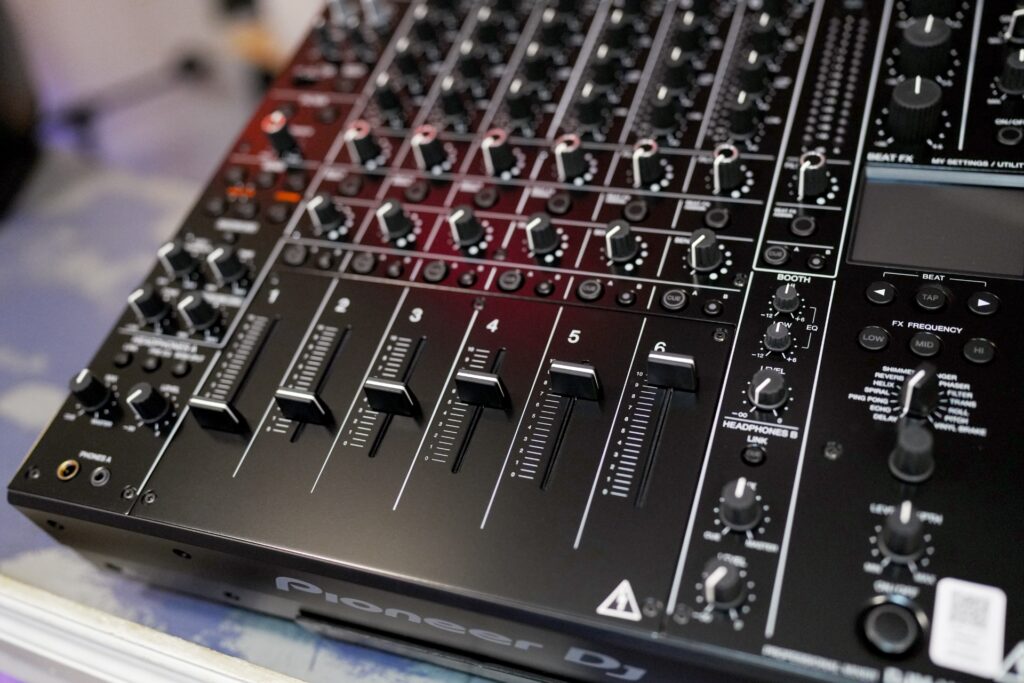
The “LF” version of the V10 is just what it sounds like: it’s a V10 with longer faders. To fit these 60mm widgets on here, they removed the Magvel Crossfader and the switches to assign it. The curves have been optimized for this, and it enables great precision in your mixing. Much like a rotary mixer, it trades the functionality of a crossfader for the adjustability of each channel. And, that’s pretty much it. This is otherwise the same mixer, and it costs $100 more.
If you are the kind of DJ who loves doing long, precise blends and never touches the crossfader, or if you have a dedicated scratch mixer, this might be the better option for you. Here’s my perspective on it. I wanted to love the V10-LF. There’s something about committing to a dedicated, precision device that makes you feel kinda hardcore.
But I’d personally choose the regular DJM-V10. After all, this is a major Pioneer DJ mixer with 6 channels and dual cue systems. If I bought this, I’d almost certainly not be the only person using it. Even if I don’t rent it out, which I’d probably consider, I’d still have DJ friends playing on this sometimes.
I can’t wrap my head around removing a major mixer function just to make the faders longer. Honestly, in several days of mixing on it, I never felt like I needed more fader length. Precision was never an issue. So, if you don’t need a crossfader and aren’t a “social DJ”, maybe the LF is for you. And I love it in theory. But if you’re choosing a Pioneer club mixer because of its “industry standard-ness”, I’d recommend the industry standard model.
Ports & Connections
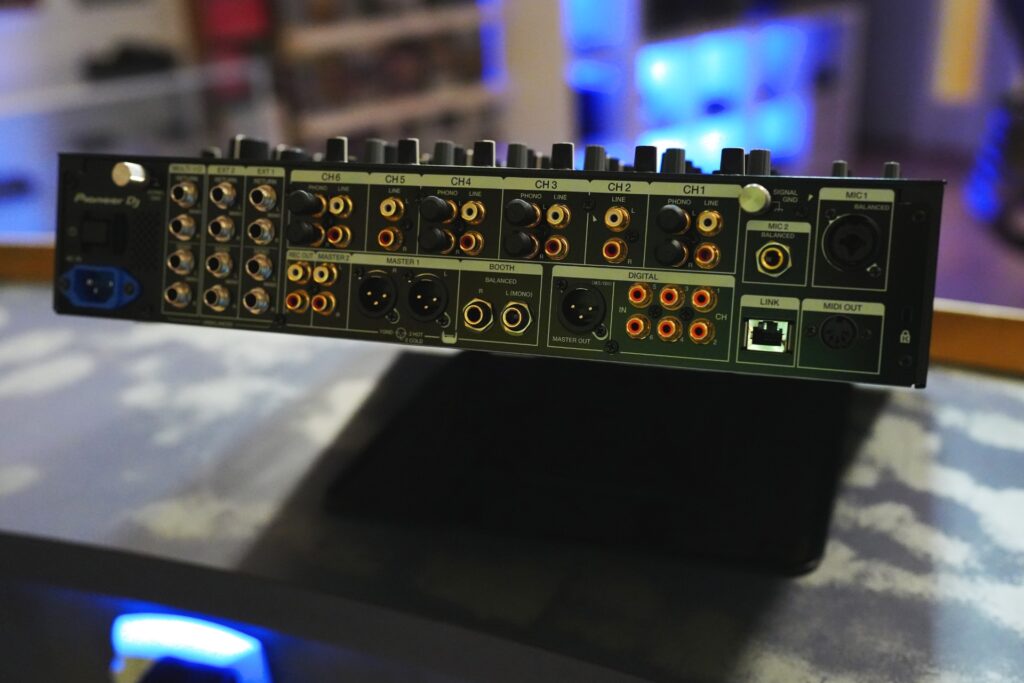
Around the back, it has connections for all the sources you may want, including 6 line and 4 phono connections, and tons of digital ins and outs for lossless connections over long runs. You can use the ethernet port to connect to your Pioneer DJ network, or even use an old-school 5-pin MIDI connection with your synth hardware. And there’s a robust send/return network. This is how we connected our guitar pedal to add FX to my little mix. You can connect 2 mics, and there are two ground pegs for turntables.
Whether your connections are analog or digital, you’re pretty much covered here. And don’t forget that you can just connect it straight to your laptop, using one of the two ports on top of the mixer.
Sound Quality & Character
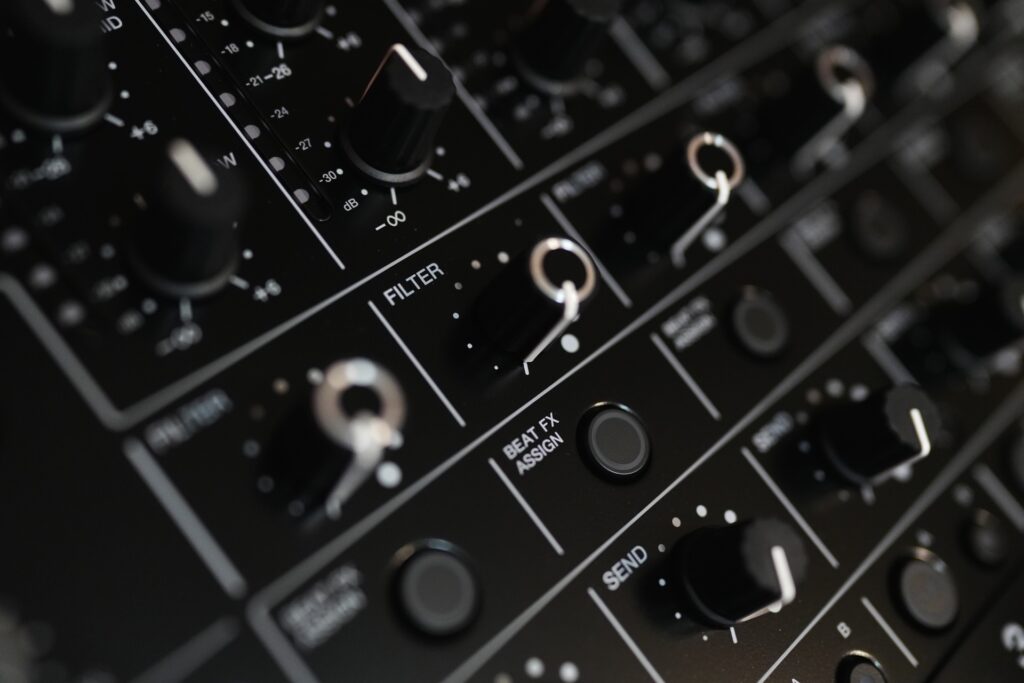
First, the technobabble: it’s got high-end 32-bit digital/analog converters, made by ESS Technology and by Asahi Kasei on the phono side. It uses high-performance mechanical relays to eliminate signal distortion, and has a 105 dB signal/noise ratio. Basically what all that means is: no matter the source, the V10 should output rich, low-noise sound. It has a vibrant presence, and sounds powerful. I wanted to compare it to the Euphonia, released by Pioneer DJ’s parent company, which I just recently reviewed. I set myself up with a little A/B test. I connected a separate laptop to both mixers over USB, running rekordbox software. I played the same song on each, in sync, and set them to the same gain levels.
I connected both mixers directly to my powered QSC K-12 speakers, which conveniently have 2 sets of inputs, for just such an occasion.
I made sure the Master Outs weren’t being modified by the Isolators, and that all the EQs and filters were zeroed out. I know that psychologically, we tend to prefer a louder sound at first. So, I used an old dB meter to make sure each mixer was giving me a similar perceived volume. I made sure the track on the Euphonia wasn’t being pushed into the “saturation” zone, as I just wanted a clean comparison first. Then, I just listened back and forth. When configured this way, in my own studio with these speakers, the mixers sound fairly similar. Which is to say, very good. But it was honestly difficult to tell if I was hearing any actual difference, or if it was just in my head. Then, I wanted to use the Euphonia’s analog circuitry as intended. I pushed the levels up to get into some analog saturation, and boosted the isolator bands a bit (on each mixer). Then, re-checked my levels and my dB meter to make sure they were putting out a similar volume. Here, I could notice more of a difference. It’s hard to describe, and it’s very subtle. I think I heard a little more pronounced stereo separation on the Euphonia. And, contrary to my thinking, I heard more clarity in the midrange. There’s stuff going on in there that’s just presented with more clarity on the Euphonia, where I was expecting more of a simple “beefing up” of the bass and treble.
The V10 might have a touch more presence in the high-end, where the Euphonia has more clarity in the midrange. But, look. Whether it’s because I don’t have a properly sound-treated studio with high-end monitors, or because I don’t have magic ears, I had to listen really hard to hear these differences. I’m nitpicking for the sake of the review, but the truth of the matter is: with a blindfold on, I wouldn’t be able to tell you which is which. They both sound great. There are a handful of mixers you could compare the V10 to, and the most similar is probably the Allen & Heath XONE:96.
Unfortunately I don’t have this in the room with me now, and I can’t perform the same A/B sound test. But this is another great-sounding mixer, and it probably sounds a lot like a DJM-V10. What I can talk about is the design of these two mixers. In this sense I very much prefer the V10. I mentioned in my XONE review that while I loved that mixer, its design is very “fussy”, and unnecessarily complicated. Looking at one is a bit stressful.
But that’s not at all my experience with the V10. I hooked it up and immediately knew what everything did. There’s symmetry where it belongs. All 6 channels work in basically the same way. The main parts of the mixer work the same way a DJM-600 did over 20 years ago, and the newer tech is laid out in a way that makes sense. You also get a ton of good FX with the V10, where you have to basically BYOFX to the XONE. Of course, XONE EQ and filters are legendary, AND it’s about $1200 cheaper than the Pioneer – so take that into consideration.
Who It’s For

If you’re a DJ, or especially a DJ/live act hybrid, who wants to be able to connect various sound sources and route them, who cares about sound quality, this is the mixer for you. It enables you to get precise and surgical with your individual tracks, and mix them how you want. Whereas the Euphonia we compared it with, is for the DJ who wants to let the individual song speak for itself – while enriching it with analog harmonics, and outputting the best possible sound. I hope that what you take away from this review is the V10’s versatility. No matter what you want to connect – whether it’s a modern digital track, a classic vinyl record, or an analog synth provided by a 40-year-old computer – this mixer has the capability of bringing these various signals together cohesively.
As with all Pioneer DJ mixers, the price point will be a major deciding factor. The V10 is not cheap. However, the person buying this is quite likely buying their “forever mixer”, and it seems to be a good choice for that, indeed.
Your Turn
We put a lot of love into these reviews to serve you, our friends, and the global community of DJs.
If you found this useful, please support by
- Sharing this post on your socials (or texting it to another DJ who’ll benefit)
- Leaving a comment below with what you’re most excited about the Pioneer DJ DJM-V10 (or why it’s still not what you’re looking for)
- Subscribing to the Passionate DJ Podcast
- And if you are looking to pick up one of the Pioneer DJ DJM-V10 (or any other gear), consider purchasing from The DJ Hookup, which makes this possible. Ask us for the below-advertised pricing and we’ll be happy to hook you up!
Looking to pick up a Pioneer DJ DJM-V10 (or other dj gear)?
Let us hook you up.
Click here & ask us for discounts and best deals!
2 thoughts on “Pioneer DJ DJM-V10/LF Review – Hands-On Deep Dive”